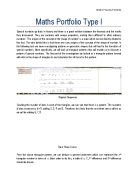These are the “original” start numbers 1 and 1.
By investigating the Fibonacci numbers, I can make a conjecture, that the ratio of two consecutive terms gets closer, as they increase, to the Golden Ratio. By changing the start numbers I proved that it doesn’t make a difference which numbers we use.
To prove my conjecture I’ve changed the equation and solved it. Afterwards I found the discriminant (5), which leads me to find the roots. I plugged in the discriminant to the quadratic equation for finding the roots. The results for the positive root is, 1.618 and the negative root is, -0.618. This proves my conjecture. Look below to see my calculations and explanations.
I divided both sides of this equation Un = Un-2 + Un-1, by Un-1.
= 1 + = Why we do it?
= 1 +
Here, is one of the numbers in the column above, it gets closer and closer to 1.618, which I will call x. On the other side of the equation, is the reciprocal
of one of the numbers in the same column, so it gets closer to .
Now the equation looks like this;
x = 1 +
By rearranging the equation into a quadratic one, I can find the discriminant, which leads to the finding of the roots.
x2 – x -1 = 0
Calculate the discriminant:
d = b2 – 4 ∙ a ∙ c
d = (-1)2 – 4 ∙ 1 ∙ -1
d = 5
Calculate the roots:
x = -b +-
x = -1 +- =
Roots are 1.618 and -0.618.
After calculating the roots, I observed that the negative reciprocal of the Golden Ratio was found. Actually, - 0,618 is the limit of consecutive ratios. This is done by going backwards in the table i.e. U3, U2, U1, U0, U-1, U-2, U-3 etc. I noticed that you´ll reach the inverted Golden ratio -0.618 faster than its reciprocal. I also made table that proves my statement above.
The Fibonacci numbers and the Golden Ratio can also be found in nature. They appear in the leaf arrangement in plants, in the pattern of a flower, the bracts of a pinecone, or the scales of a pineapple. The Fibonacci numbers are called the Natures Numbering system. It´s still a mystery why they appear in nature. The ratio between squares is also connected to the Golden ratio. I made some squares that show that the ratio between them is the Golden Ratio.
These are the Fibonacci squares. The ratio between the sides of the squares is 1.618 – the golden ratio. It starts by two small 1 by 1cm. The next one is 1 by 2, 2 by 3 and so on.
The Greeks used the in the design and construction of the Greek temple (Parthenon).
To prove that the Greeks really used the golden ratio in the design, I’ve measured the sides. The first square is 1cm by 1cm; the next is 1cm by 2 cm and so on. Look in the table below to see the ratio between each side.
Appendix
1)
I changed to two “start numbers” to 1 and 7, and by making a table and a graph I proved that it doesn’t matter which numbers we use to get the Golden Ratio.
To show that we would eventually get the same result, no matter what “start numbers” were, I plugged in -9 and 5. To prove that with even a negative number, we would reach the Golden Ratio.
I also tried to plug in decimal numbers to see what happened. I plugged in 2,6 and -1,9.
2)
The inverted Golden Ratio can be found by dividing Un-1 by Un-2. As you can see below, the inverted ratio is reached much faster, than the opposite.







